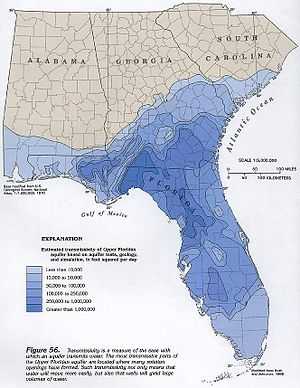Floridan aquifer

The Floridan aquifer is a portion of the principal artesian aquifer that extends into Florida[1] and is composed of carbonate rock and located beneath the coastal regions of the Southeastern United States and is one of the world's most productive aquifers.[2] It is under all of Florida as well as large parts of coastal Georgia and areas of coastal Alabama and South Carolina.[3]
History
In 1936, geologist Victor Timothy Stringfield first identified the existence of Floridan Aquifer in peninsular Florida and referred to the carbonate units as the "principal artesian formations." In 1944, M. A. Warren of the Georgia Geological Survey described an extension of this system in south Georgia and applied the term "principal artesian aquifer" to the carbonate units involved. In 1953 and 1966 Stringfield also applied the term "principal artesian aquifer" to these rocks. In 1955, Garald G. Parker noted the hydrologic and lithologic similarities of the Tertiary carbonate formations in southeast Florida, concluded that they represented a single hydrologic unit, and named that unit the "Floridan aquifer".

Location
The Floridan aquifer, as opposed to surficial aquifers, is the portion of the principal artesian aquifer that extends into Florida, parts of southern Alabama, southeastern Georgia, and southern South Carolina. In Florida it supplies the cities of Daytona Beach, Deltona, Flagler Beach, Gainesville, Tampa, Jacksonville, Ocala, Orlando, St. Petersburg, and Tallahassee, several municipalities in South Florida, and numerous rural communities.
Hydrology
The principal artesian aquifer is the largest, oldest, and deepest aquifer in the southeastern U.S. Ranging over 100,000 square miles (260,000 km2), it underlies all of Florida. The aquifer developed millions of years ago during the late Paleocene to early Miocene periods, when Florida was underwater. Wakulla Springs in Wakulla County is one of a number of major outflows of the aquifer with a flow rate of 200–300 million US gallons (757,082 - 1,135,623 cubic meters) of water per day. A record peak flow from the spring on April 11, 1973, was measured at 14,324 US gallons (54,220 l; 11,927 imp gal) per second - equal to 1.2 billion gallons (4,542,494 cubic meters) per day.

Groundwater in the Floridan aquifer is contained under pressure by a confining bed of impermeable sediments. When the water pressure is great enough, the groundwater breaks to the surface and a spring flows. Water temperature and flow from a Floridan spring are relatively constant.
In general, as water flows through the Floridan aquifer system, the water quality becomes more alkaline and the sulfate content increases as does the amount of dissolved solids.[3]
See also
References
- ↑ "Florida aquifers - Plant Management in Florida Waters". The University of Florida: Center for Aquatic and Invasive Plants. Retrieved 2008-06-01.
- ↑ USGS Ground Water Atlas of the United States HA 730-G
- ↑ 3.0 3.1 Anthony F. Randazzo, Douglas Sl Jones, (Eds) (1997). The Geology of Florida. University Press of Florida. pp. 82–88, 238. ISBN 0-8130-1496-4.
External links
| ||||||||||||||||||||||||||||||||||||||||||